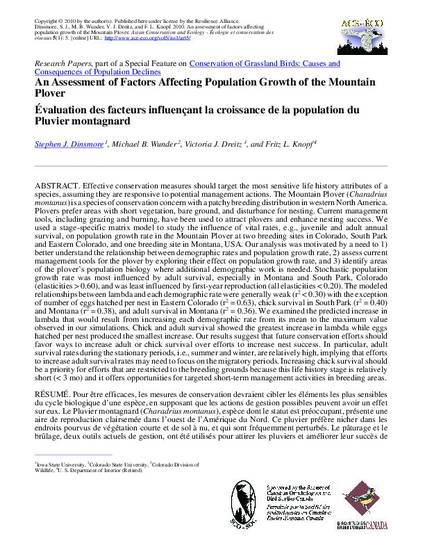
Effective conservation measures should target the most sensitive life history attributes of a species, assuming they are responsive to potential management actions. The Mountain Plover (Charadrius montanus) is a species of conservation concern with a patchy breeding distribution in western North America. Plovers prefer areas with short vegetation, bare ground, and disturbance for nesting. Current management tools, including grazing and burning, have been used to attract plovers and enhance nesting success. We used a stage-specific matrix model to study the influence of vital rates, e.g., juvenile and adult annual survival, on population growth rate in the Mountain Plover at two breeding sites in Colorado, South Park and Eastern Colorado, and one breeding site in Montana, USA. Our analysis was motivated by a need to 1) better understand the relationship between demographic rates and population growth rate, 2) assess current management tools for the plover by exploring their effect on population growth rate, and 3) identify areas of the plover’s population biology where additional demographic work is needed. Stochastic population growth rate was most influenced by adult survival, especially in Montana and South Park, Colorado (elasticities > 0.60), and was least influenced by first-year reproduction (all elasticities < 0.20). The modeled relationships between lambda and each demographic rate were generally weak (r2 < 0.30) with the exception of number of eggs hatched per nest in Eastern Colorado (r2 = 0.63), chick survival in South Park (r2 = 0.40) and Montana (r2 = 0.38), and adult survival in Montana (r2 = 0.36). We examined the predicted increase in lambda that would result from increasing each demographic rate from its mean to the maximum value observed in our simulations. Chick and adult survival showed the greatest increase in lambda while eggs hatched per nest produced the smallest increase. Our results suggest that future conservation efforts should favor ways to increase adult or chick survival over efforts to increase nest success. In particular, adult survival rates during the stationary periods, i.e., summer and winter, are relatively high, implying that efforts to increase adult survival rates may need to focus on the migratory periods. Increasing chick survival should be a priority for efforts that are restricted to the breeding grounds because this life history stage is relatively short (< 3 mo) and it offers opportunities for targeted short-term management activities in breeding areas.
Available at: http://works.bepress.com/stephen_dinsmore/100/

This article is published as Dinsmore, Stephen, Michael Wunder, Victoria Dreitz, and Fritz Knopf. "An assessment of factors affecting population growth of the Mountain Plover." Avian Conservation and Ecology 2010, 5(1).